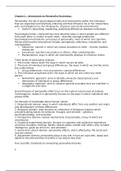Chapter 1 – Introduction to Personality Psychology:
Personality: the set of psychological traits and mechanisms within the individual
that are organized and relatively enduring and that influence his or her interactions
with, and adaptions to, the intrapsychic, physical, and social environments
Useful in describing, explaining, predicting differences between individuals
Psychological traits: characteristics that describe ways in which people are different
from each other or similar to each other – describe average tendencies
Psychological mechanisms: processes of personality, most of which are cognitive
Person-environment interactions include: perceptions, selections, evocations, and
manipulations
Selections: manner in which we choose situations to enter – friends, hobbies,
classes etc.
Evocations: reactions we produce in others, often unintentionally
Manipulations: ways in which we intentionally attempt to influence others
Three levels of personality analysis:
1. The human nature level: the ways in which we are all alike
2. The level of individual and group differences: the ways in which we are like some
but unlike others
Group differences: men and women, cultural differences
3. The individual uniqueness level: the ways in which we are unlike any other
person
Nomothetic approach: aims to identify universal characteristics and
dimensions of individual or group differences
Idiographic approach: aims to observe general principles that are manifest in
a single life over time
Grand theories of personality often focus on the human nature level of analysis
Contemporary research in personality focuses on the ways in which individuals and
groups differ
Six domains of knowledge about human nature:
1. Dispositional domain: ways in which individuals differ from one another and origin
and development of these differences
2. Biological domain: sees humans as collections of biological systems which
provide building blocks for behavior, thought, and emotion – genetics,
psychophysiology, and evolution
3. Intrapsychic domain: mental mechanisms of personality, many of which are
unconscious
4. Cognitive-experiential domain: focuses on cognition and subjective experience;
conscious thoughts, feelings, beliefs, desires about oneself and others, also includes
intelligence, goals we strive for, and emotions
5. Social and cultural domain: personality affects, and is affected by the social and
cultural context
6. Adjustment domain: personality plays a key role in how we cope with, adapt and
adjust to the ebb and flow of events in our day-to-day lives
Five scientific standards for evaluating personality theories:
1
, Comprehensiveness: explains most or all known facts
Heuristic value: guides researchers to important new discoveries
Testability: makes precise predictions that can be empirically tested
Parsimony: contains few premises or assumptions
Compatibility and integration across domains and levels: consistent with what
is known in other domains
Chapter 2 – Personality Assessment, Measurement and Research Design:
Sources of personality data:
1. Self-report data (S-Data)
Experience sampling: people answer some questions every day for several
weeks or longer
2. Observer-report (O-Data)
Multiple observers help establish interrater reliability
Using multiple intimate observers aids in assessing multiple social
personalities
3. Test data (T-Data): places participants in standardized testing situation in order
to determine whether different people react differently to an identical situation
Mechanical recording devices
Physiological data – fMRI
Projective techniques – inkblot
4. Life-outcome data (L-Data): information gleaned from events, activities, and
outcomes in a person’s life available to public scrutiny
Aggregation: process of averaging several single observations, resulting in a more
reliable measure of a personality trait
Evaluation of personality measures:
1. Reliability
Response sets: tendency of some people to respond to the questions on a
basis unrelated to question content
2. Validity
3. Generalizability
Development of measurement instruments:
Focus groups: groups representative for the population at which the instrument is
targeted – test preliminary test banks
Research designs in personality:
1. Experimental methods
Counterbalancing order of conditions establishes equivalence by ruling out
order effects as a consequence of being exposed to one condition first
2. Correlational studies
3. Case studies: most often used as a source of hypotheses and means to illustrate
a principle
Part 1 – The Dispositional Domain
2
, Chapter 3 – Traits and Trait Taxonomies:
Traits can be described as:
1. Internal causal properties
2. Purely descriptive summaries
Personality coherence: the shifting of the manifestation of personality with age
States: vary across time and situations and are within-subject variations of behavior
– emotions
Act frequency approach: scoring high on a trait reflects the trend of performing a
large number of acts within a certain category relative to others
Three approaches to identifying important traits:
1. Lexical approach: all traits listed and defined in the dictionary form the basis of
the natural way of describing differences between people – 2 criteria for identifying
important traits:
Synonym frequency
Cross-cultural universality
2. Statistical approach: uses factor analysis and other statistical procedures to
identify major personality traits
3. Theoretical approach: relies on theories to identify important traits by strictly
determining which variables are important
Taxonomies of personality:
1. Eysenck’s hierarchical model of personality
2. Cattell’s 16 personality factor system
3. Circumplex model of personality – interpersonal circumplex:
Concerns interpersonal traits
Interpersonal is defined as interactions between people involving exchanges
Two resources defining social exchange are love and dominance
Advantage of providing an explicit and precise definition of interpersonal
transactions
Advantage of specifying relationships between each trait and every other
trait within the model
Specifies three types of relationships: adjacency, bipolarity, orthogonality
4. Five-factor model: list of words describing stable traits from the dictionary was
used for a lexical and subsequent factor analysis
Extraversion – introversion
Agreeableness – aggressiveness
Conscientiousness
Emotional stability – neuroticism
Openness
> High replicability
5. HEXACO model of personality: additional factor honesty-humility added to the
five-factor model
Neuroticism in the big five includes a quick temper and irritability, in the
HEXACO model these fall under agreeableness
3





